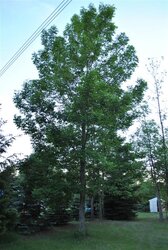This ash tree is on my brothers mother in laws property. It has to be the healthiest ash tree I've seen in a long time! You can see some other smaller ones in the picture that are about gone. We might actually try a soil drench on this one to see if it helps, it's a real nice tree and is worth the small effort/investment to give it a try.
My brothers property and his mother in laws have a bunch and most have seen far better days. We'll be taking out some this year and the rest will probably make it another season or two before we cut them.
My brothers property and his mother in laws have a bunch and most have seen far better days. We'll be taking out some this year and the rest will probably make it another season or two before we cut them.


